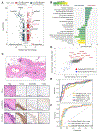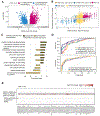Multi-omic profiling of intraductal papillary neoplasms of the pancreas reveals distinct patterns and potential markers of progression
- PMID: 40882635
- PMCID: PMC12482137
- DOI: 10.1016/j.ccell.2025.08.001
Multi-omic profiling of intraductal papillary neoplasms of the pancreas reveals distinct patterns and potential markers of progression
Abstract
To enable early detection of pancreatic cancer from precancerous lesions, we analyze proteins and glycoproteins from 64 intraductal papillary mucinous neoplasms (IPMNs), 55 cyst fluid samples, 104 pancreatic ductal adenocarcinomas (PDACs), and various types of normal samples using mass spectrometry. High-grade IPMNs show enrichment of glycosylation level and tumor progression pathways compared to low-grade lesions. High-grade IPMN associated proteins, such as PLOD3, IRS2, LGALS9, and Trop-2, are identified and validated using immunolabeling and laser microdissection. Some high-grade associated proteins are also detected in pancreatic cyst fluids, which allows us to link proteins and glycoproteins expressed in neoplastic cells to clinically accessible biospecimens. Altered glycosylation level of extracellular matrix (ECM) proteins is observed in IPMNs compared to normal ducts. Additionally, we identify a subset of IPMNs with PDAC-like features, including elevated expression of ECM proteins. These findings offer insight into progression-associated proteins and emphasize the diagnostic and therapeutic potential of these proteins in pancreatic tumors.
Keywords: IPMN; early detection; extracellular matrix; glycoproteomics; pancreatic cancer; proteomics; tumor progression.
Copyright © 2025 Elsevier Inc. All rights reserved.
Conflict of interest statement
Declaration of interests R.H.H. has the potential to receive royalty payments from Thrive Diagnostics for the invention “Identification of GNAS mutations in pancreatic cystic lesions” in a relationship overseen by the Johns Hopkins University. A patent related to this work, titled “Biomarkers for Early Detection of Pancreatic Cancer and Use Thereof,” has been filed through Johns Hopkins University under case reference JHU Ref: C18948.
Figures




Update of
-
Multi-omic profiling of intraductal papillary neoplasms of the pancreas reveals distinct expression patterns and potential markers of progression.bioRxiv [Preprint]. 2024 Jul 7:2024.07.07.602385. doi: 10.1101/2024.07.07.602385. bioRxiv. 2024. Update in: Cancer Cell. 2025 Aug 26:S1535-6108(25)00332-0. doi: 10.1016/j.ccell.2025.08.001. PMID: 39005476 Free PMC article. Updated. Preprint.
References
Grants and funding
LinkOut - more resources
Full Text Sources
Research Materials
Miscellaneous

